Here we are. Tumbling around smoothly, sitting on the muddy seabed. As the sails are down there´s almost no pressure from the wind in our rigging, I am standing on the bow working the towing line and so I do not hear the engine, that is still running at full abaft. The boat isn´t moving a bit. Grounded! Like lightning occasional memories, blurry pictures and – most annoying of it all – the cold sweated feelings causing shivers down my spine come back, memories to a similar incident some years ago when I was skipper and ran aground myself. Oh boy – from 3.5 meter to 1.4 meters in a matter of seconds … now we´re stranded. How this happened, you may read here.
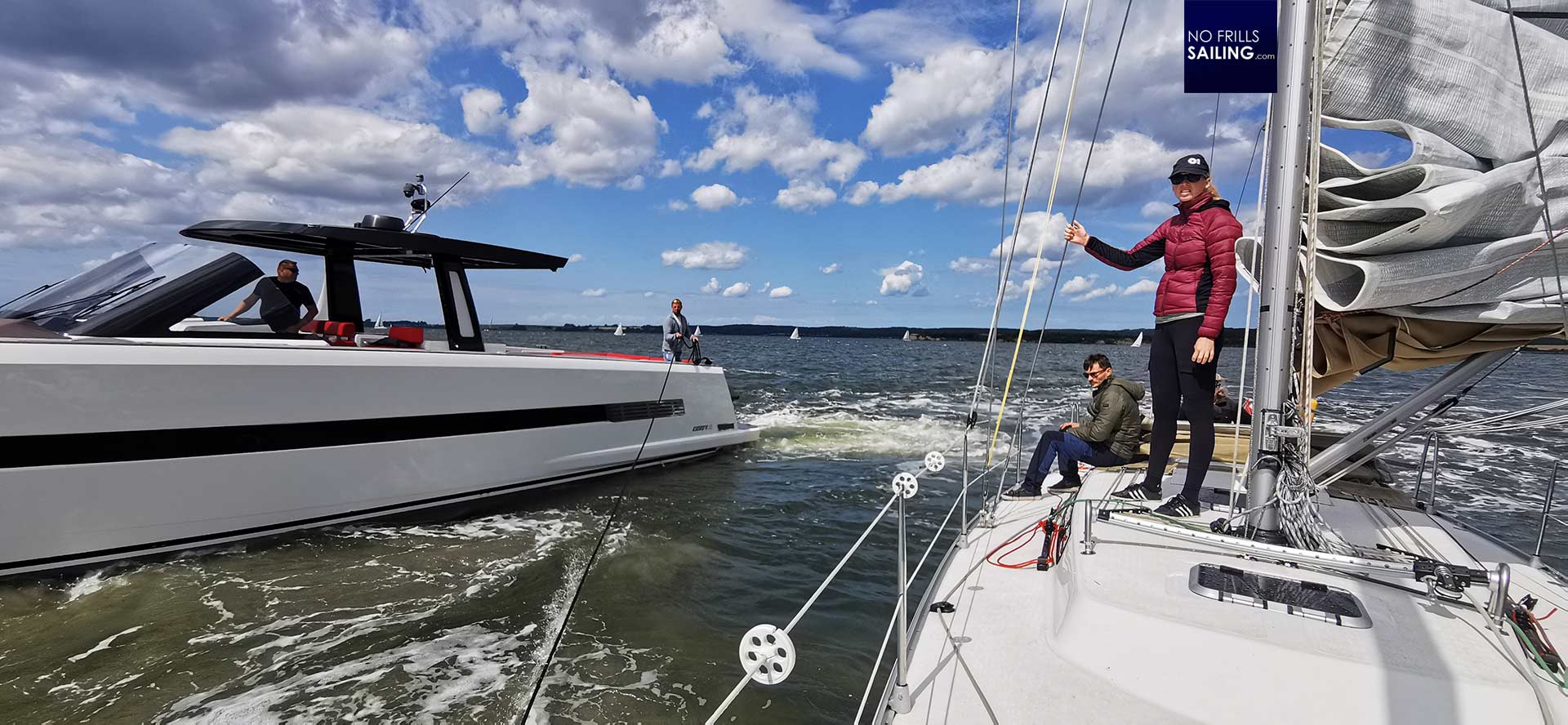
So, we are grounded apparently. But we are lucky in all our despair: As the incident happened right after the start, many auxiliary vessels are still around and so we get potted by one of them, a Fjord power boat (another brand of neighboring Hanse Yachts shipyard) which approaches us after a few minutes. We connect via towing line and now, slowly, very accurately and with lots of caution, the Fjord skipper starts to pull the boat away from the shore. Also, very slowly, reluctantly, we start to point or bow towards deeper waters. Then he starts to gradually increase the throttle to full power. Our 21 hp Diesel-engine plus their combined staggering power of 1.100 hp finally manage to slide our keel through the mud. Again, just a few meters, maybe 2 or 3 only. And then, suddenly, we slide back from the underwater shoal into the water. Afloat again. Finally! We cannot thank enough, huge stones fall from our hearts. Thanks, Fjord skipper, thanks so much!
From the back of the pack …
Technically we should be disqualified as we not only had started our own engine but needed towing assistance from another vessel. But somehow rules of this club race are different, apparently. Stefan, our skipper and owner of the Omega 42, tells me that groundings aren´t such a seldom event but happen rather often in this area. And so, other than the daughter and mother racing their little Elan who decided to go back to the marina after their grounding, we rejoin the race. Of course, the whole fleet has passed – I guess we´ve lost 15 minutes minimum, which is a huge handicap. At the horizon we can spot the fleet.

Getting up and out the sails again, luffing up, the Omega 42 points her nose to a close hauled upwind course and starts to speed up again. Cutting through the water, we sprint towards the first marker buoy. Sea state is rough, short, choppy waves with white crests batter the bow, but our WINDFAENGER very sturdy and almost unaffected marches along. Graciously the hull dances over the waves, occasionally a bigger one coming in at a slightly weird angle smashes against the low freeboard causing a huge fountain of spray to wet the first half of the yacht.
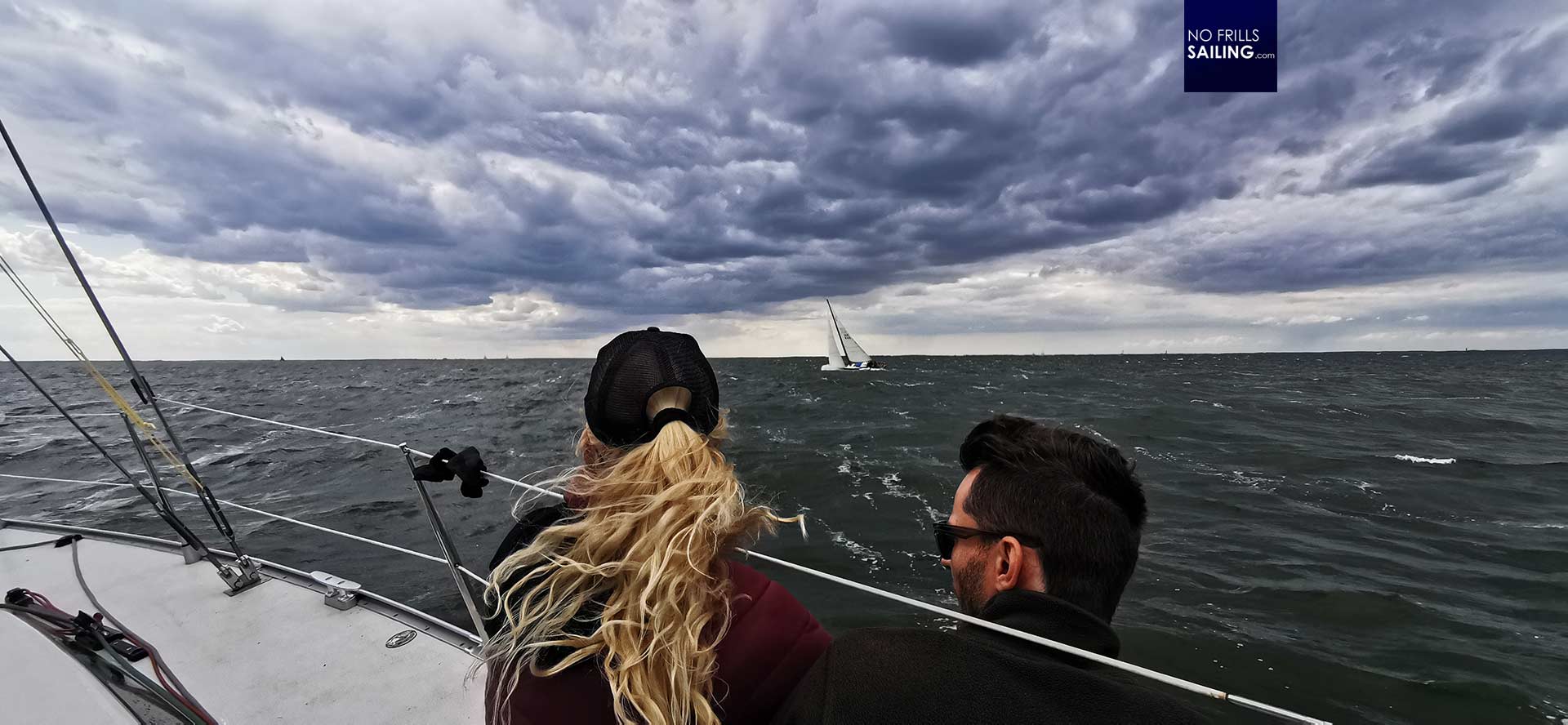
Amazingly it doesn´t take long to make good some impressive distance and to close the gap to the first (well, the last) boats of the racing fleet. Of course, these are the smaller, slower participants but nevertheless, starting to overtake other boats is a sudden boost to our morale making good for the disappointment and shame for the stupid grounding. Stefan drives the boat really hard, rather cutting the wind angle to the maximum than going for speed. In this he trades speed for more extreme pointing, hoping to arrive a bit earlier at the next buoy than some of the other boats in front of our bow.
Amazing upwind sailing performance of the Omega 42!
It´s a demonstration of sailing capabilities of this Omega 42 – the main reason (after having a fun weekend with my kids for me to come here and attend this race. I wanted to see with my own eyes how the Omega 42 behaves in strong wind conditions on all points of sail. What better occasion could there be than a regatta? In this, I at the same time can compare by just observing how this yacht performs against other boats and boat types. So, let´s take a closer look at the Omega 42 sailing capabilities when going close hauled upwind.
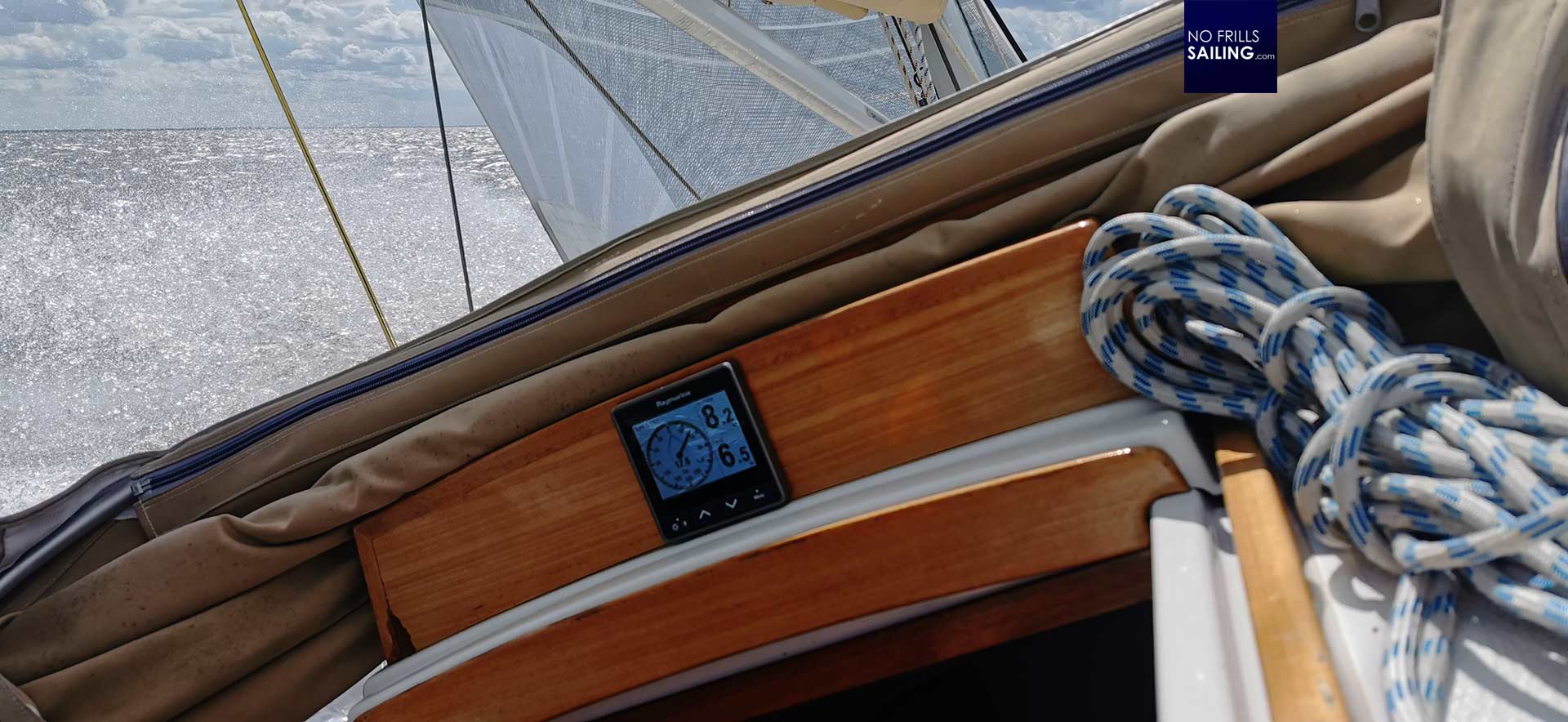
First of all, we have the Genoa completely unfurled but our main sail in the second reef. This is important to know. Also, wind speed ranges from 15 lowest to 18 knots maximum, with frequent gusts reaching 20 knots TWS. Stefan pushes the boat from just under 40 degrees TWA to 50 degrees. In this, the speed never drops under 6.5 knots when luffing extreme, hovers mainly around 7.5 to 8.5 knots, which is an amazing performance! I mean, close-hauled and reefed – 8 knots average beating upwind!
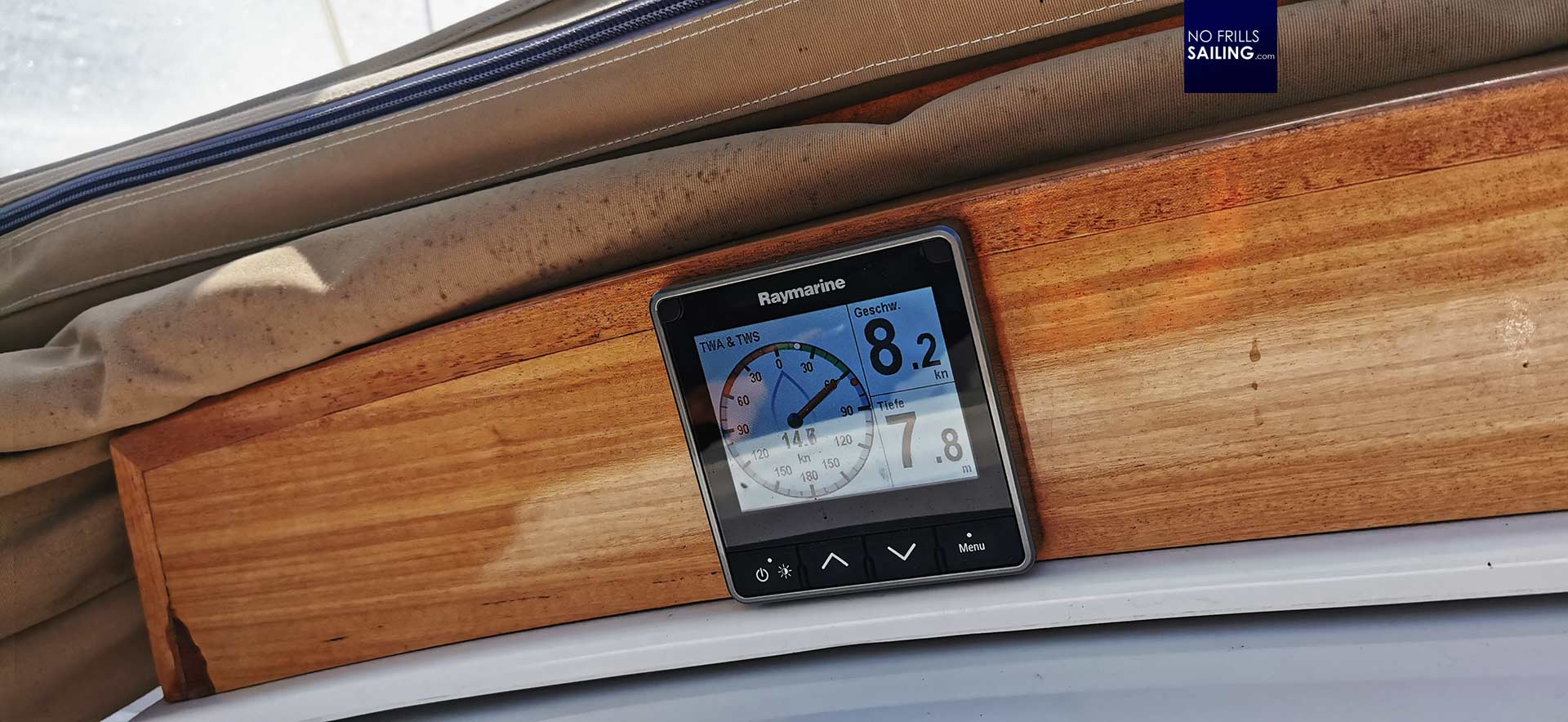
The wind is yanking at our boat, every now and then a nasty little gust is putting some more pressure into the sails. Looking back to Stefan, I find it very interesting to observe how he is coping with those gusts and the strong wind conditions back there at the tiller. And frankly, I can´t see any difference from a lush low wind afternoon-sailing. He has the tiller in his hand, parrying the gusts means a little push or pull. There is literally no pressure on the helm, no hard work at all. I ask him how much efforts he has to put into holding our boat on its due course: “Take the helm yourself – two finger-steering, no problem!”, he yells against the wind and offers the steering to me.
Seakindness built in: The hull shape matters
This sovereignty and serene supremacy, of course, is a direct consequence of Peter Norlin´s masterpiece, the hull shape of the Omega 42. She bears a relatively low draft but a comparatively long keel. If you look at the drawing of the ship´s hull you can clearly see that she is in no way a long-keeled yacht but bears a bit resemblance – her directional stability is one outcome of the special shape of her lateral plan. Keeping her sturdy “on track” is done by the keel-hull combination so that less stabilizing efforts must be performed by the rudder. This in itself remains to do what is left: Just steering the boat.
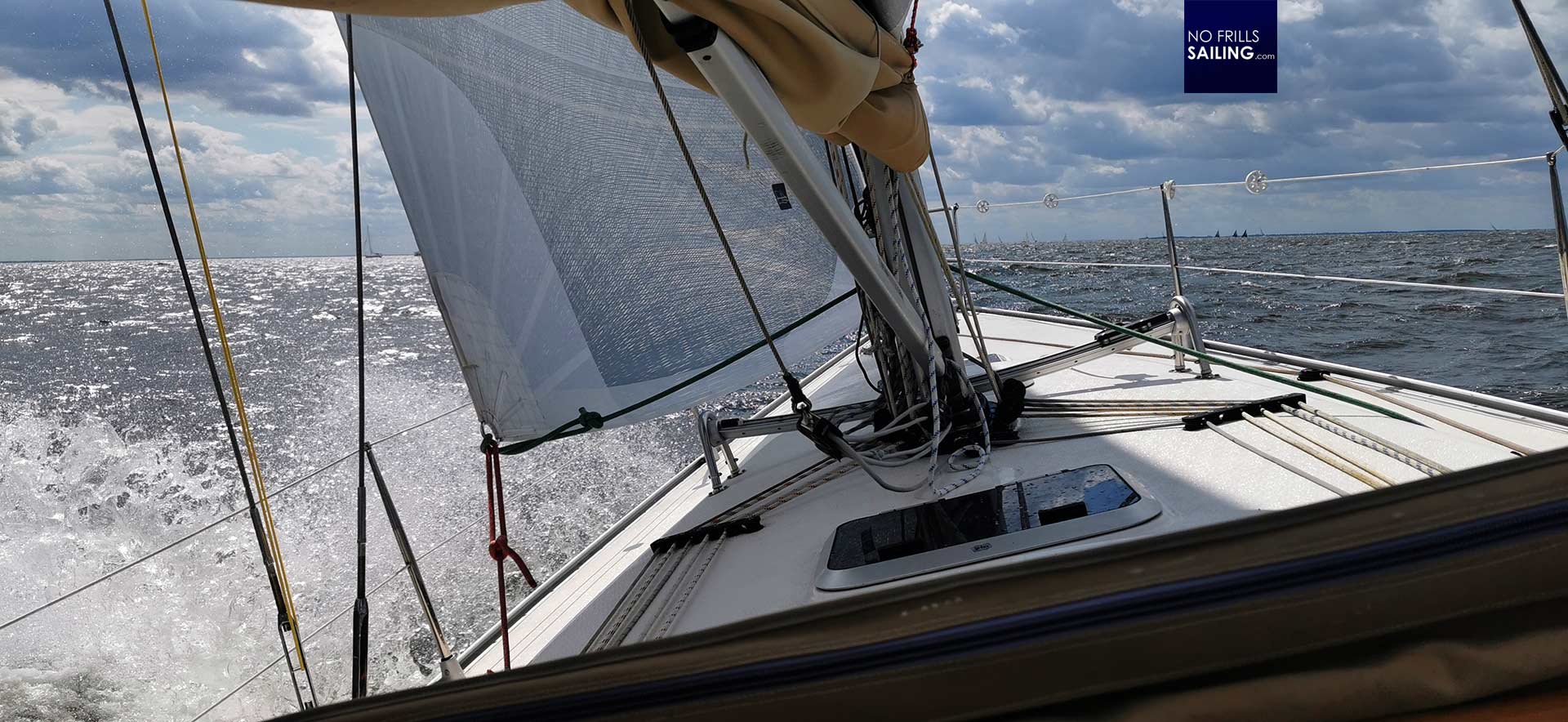
This absolute balance, something you seldom feel with modern boats today, which are very nimble – one could also say, nervous – is a key feature of the Omega 42 sailing performance. The boat is absolutely stable and won´t produce any weather helm at all. When a gust starts to exert more and more pressure into the sails, she will heel over just a bit more, surplus energy of the wind is getting away at the sail´s top while the rest is transformed into more forward motion. In all of this, you don´t feel any more pressure on the rudder – something that would make me describe the Omega 42´s steering characteristics as concerted, superior and effortless. Amazing! Her hull is in now way only pretty: She indeed is a very powerful sailboat!
Speading downwind
We reach the first marker buoy and bear away. Opening up the sails WINDFAENGER instantly stops most of the heeling returning to a more upright sailing angle. The crew is relieved and happily starts to use the toilet to let go some of the pressure of the excitement of the first part of this race.
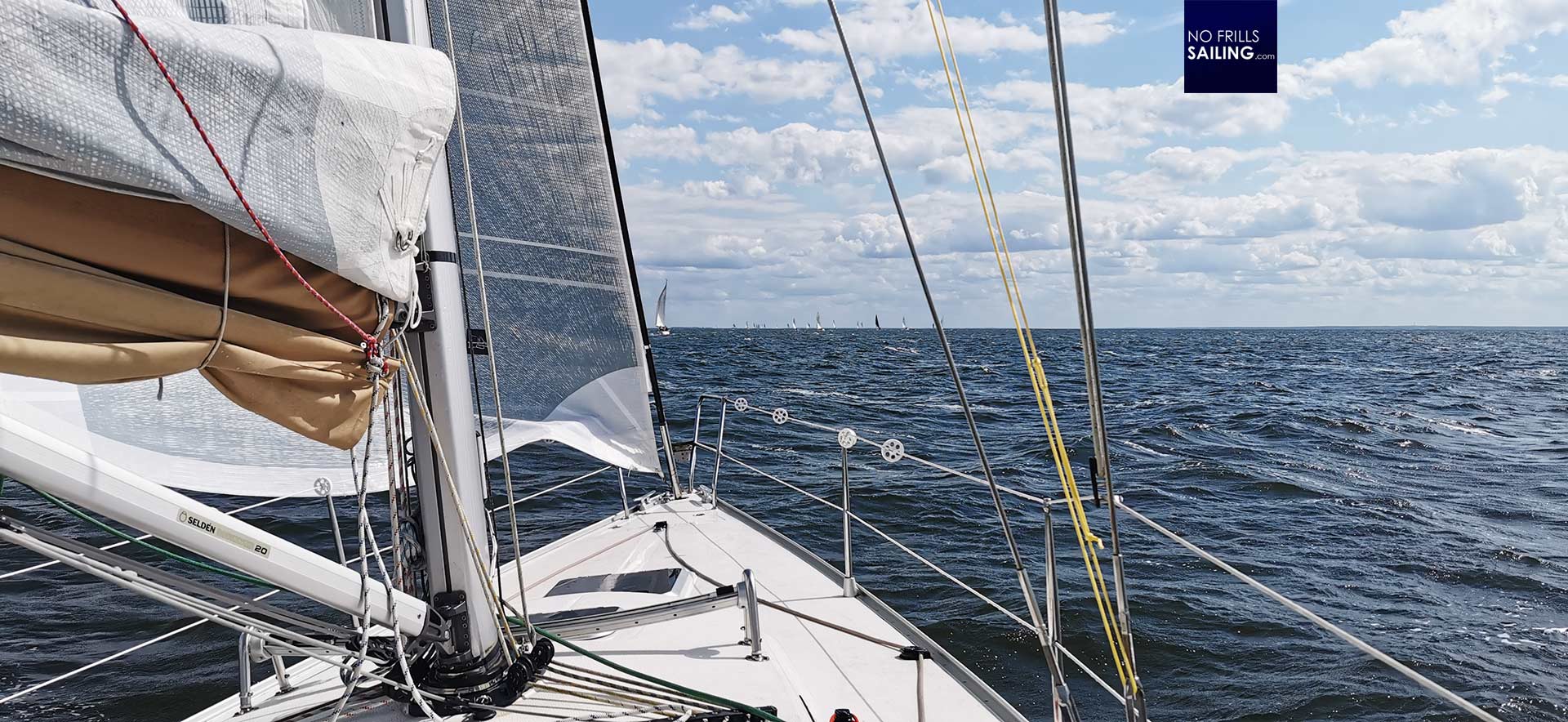
Now, on a beam reach, I am eager to see how she performs on this point of sail. We still sail under full Genoa and second reef in the main. The waves, now going by underneath the hull, are moving the boat gently. My kids return back on deck as they chose to remain underneath during the past upwind beating-session. As the sun is shining and we have less headwind, conditions suddenly change from “wet pursuit mode” to vacation-like quick sailing. I observe our log. The speed never drops beneath 8 knots and regularly overshoots the 9 knots. Still, a very good average in a 15 to 18 knots wind situation. Surely, all those planning boats now have their most powerful leg of the race and will speed away, but still: Fully reefed 8 to 9 knots is something I would be very happy with.
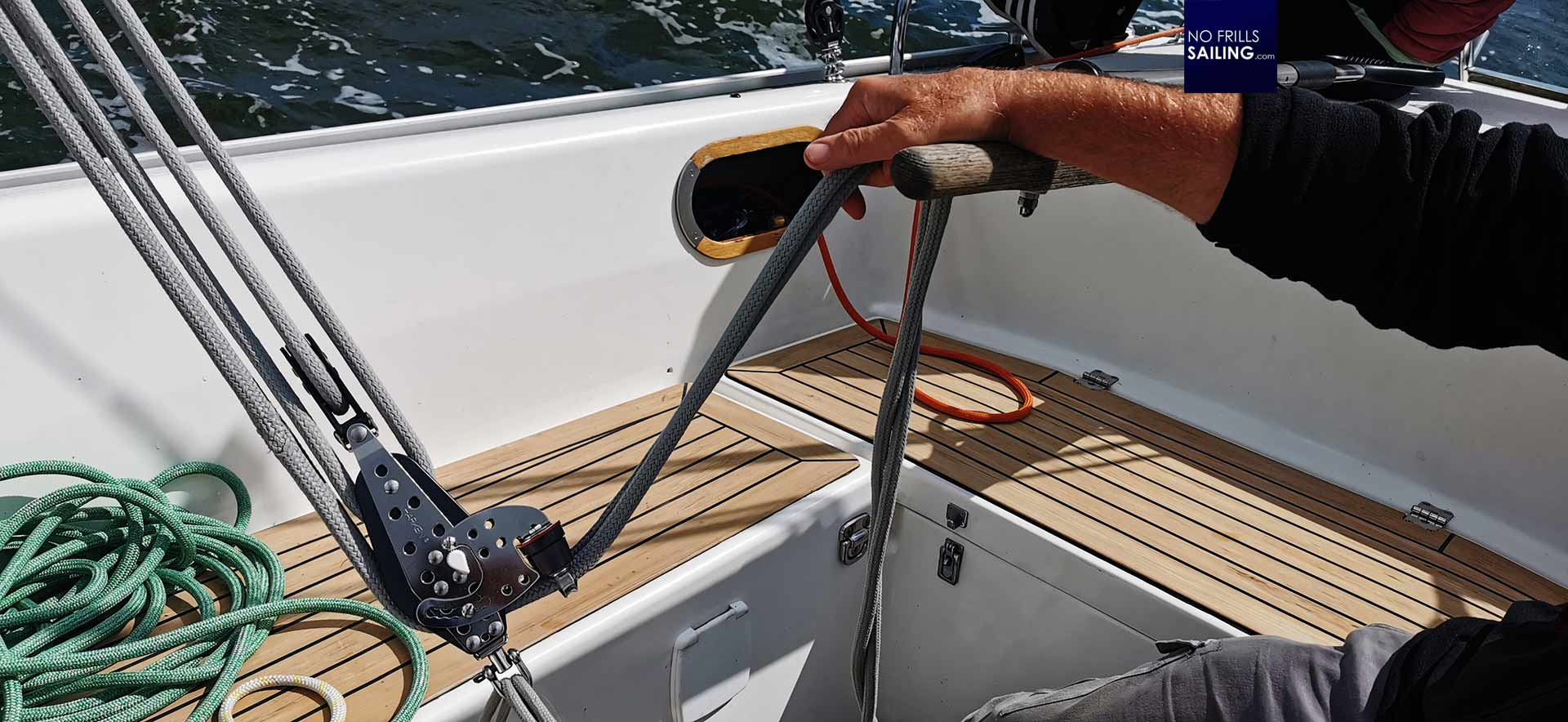
Stefan relieves me from duty at the main sheet. Casually he holds the rope of the main sheet in the same hand of the same arm that steers the Omega. He smiles: Now he is in his element. In a distance we spot one of the participants taking out the gennaker and probably speeding away from the field. Later, during the winner´s ceremony, they will mention that part of the winning was the Gennaker. Stefan refrained from even taking on the large low wind sail to the boat as – and I am backing him in this decision – with 15 to 18 knots we are slightly above the limit of safe usage of a cruising gennaker. Also, Willy (his son) and I aren´t a well-rehearsed team and the gennaker of the Omega 42 is a pretty huge blister! In any case, we are happy about this reaching leg. Almost holiday like …
A bit of a breather
Willy´s girlfriend ceases the opportunity and opens a can of ready mixed ice-cold cocktail. I am personally not a friend of alcohol whilst sailing, but as she hasn´t got any task to fulfil in sailing the boat (Willy and myself are operating the sheets), this is okay. Sitting on the deck of the high side of WINDFAENGER, we enjoy this “calm” moment, have the sun shine brightly on our noses and let our brain fly away for a moment.
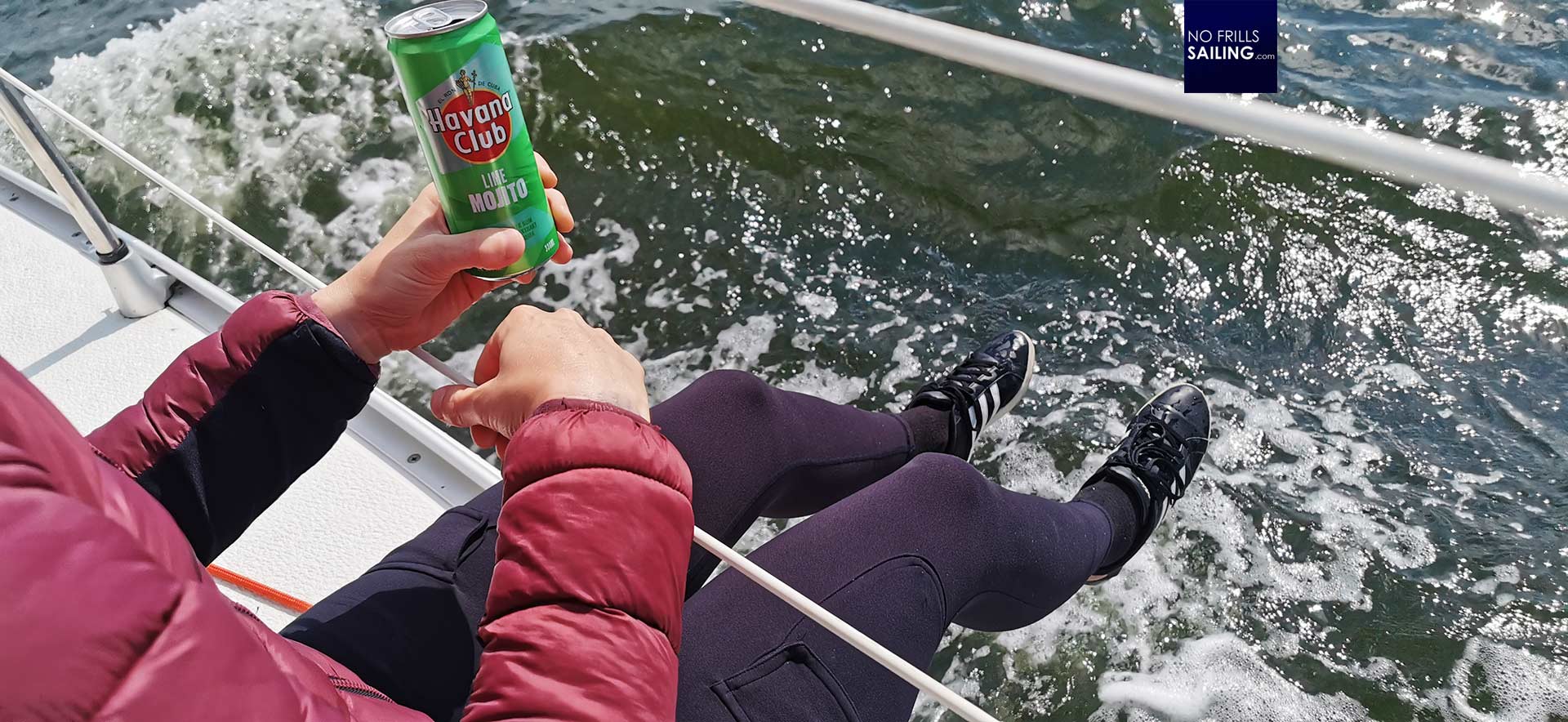
I look around and again appreciate the beauty of this landscape. There is an almost Sweden-like feeling to this place. Ruegen and also the neighboring island of Usedom are absolutely beautiful places! Especially the southern parts with their less dense population, almost no tourism (that is concentrated to the northern parts where the open Baltic Sea shore is) and loads, load and loads of green, lush, empty bays, rushes and inshore areas.

I feel at home in this region, yet I have little to no sailing experience here. It is funny, I think to myself, that it rather draws me to foreign countries and distant shores and yet here´s such a concentration of rich beauty on my doorstep I have no clue about … If a little harbor like Seedorf, where we started our journey, is the average of all the little marinas around Ruegen, then this must be surely one of my first destinations to explore when my own boat is finished!
Talking the sails configuration of the Omega 42
Back from my daydreams, I look up into the sails of WINDFAENGER and start thinking about my own boat. Which sails-configuration is best for me? I have already talked with Quantum about the sails for ALPHA. Initially, Peter Norlin envisioned the Omega 42 to carry a small self-tacking Jib and a large full batten main sail. Later versions – as this one has too – provided the boat with an overlapping Genoa. Stefan utilizes both sails and chooses his set-up before every new mission. For many reasons, I do not want to have both headsails.
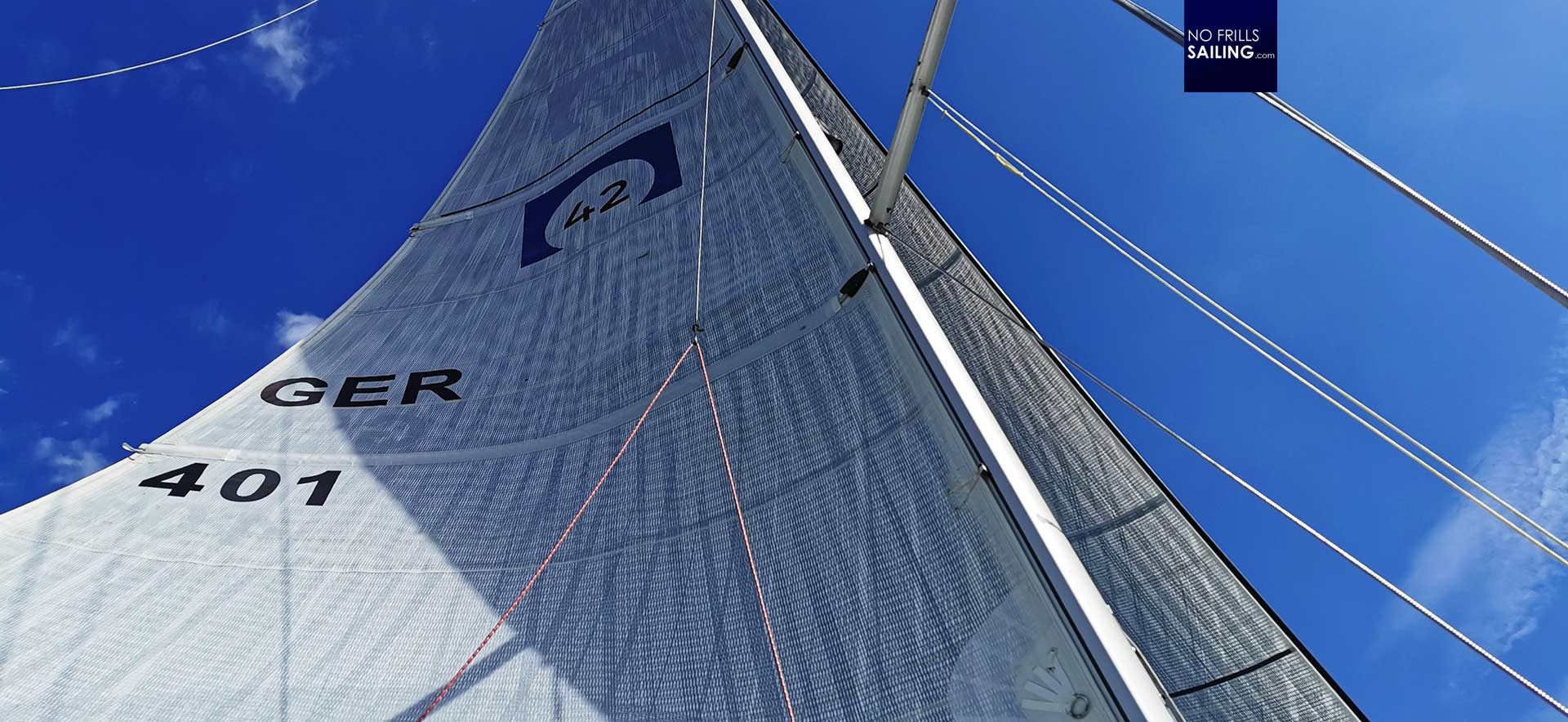
First of all, keeping the side decks clean of the sheets leads will help to keep a clean look free of the traveler tracks and the ropes. Secondly, Norlin had intended and calculated the boat to do so. Third: It will safe some money, one less sail to pay for. And fourth: I love gennaker-sailing so much that I rather think of buying a second blister for medium wind conditions of 15 to 18, maybe 20 knots, and a classic A3 touring gennaker for really low winds. Besides, back to this race, I am sure that we would have made at least a fraction better speed with some less forward pointing pressure center of the sails by having chosen to utilize the small Jib and maybe have only one reef in the main. I guess Stefan wanted to play safe, because some of the contradicting weather forecast models were predicting that around early afternoon the wind would drop significantly as low as 8 knots TWS, which, in turn, would have favored a full main and full genoa more, than Jib plus main. “Ready at the sheets!”, Stefan announces: Our comfortable reaching vacation leg was drawing to an end – the next buoy was well in sight.
Buoy dispute
In the meantime the Omega 42 has marched through the end of the regatta field with elegance. We managed to outperform a Dufour 36 Performance, another 38-footer and had – quite as a surprise – a 30ish flat-sterned planning boat almost 3 ship lengths ahead. Summoning all to the next marker buoy, it promised to be an exciting moment. Stefan hauled in some of the sheets and took the buoy almost exactly ahead, pointing the Omega´s bow at her. The other two boats had some more leeway and began to luff to starboard, but we already had under two boat lengths to the buoy and – wind from starboard side – the right of way. So far, so good. But then it happened: At full speed from windward side, a big, around 40 to 42 feet, classic sloop approached us. The crew yelling at us from afar.
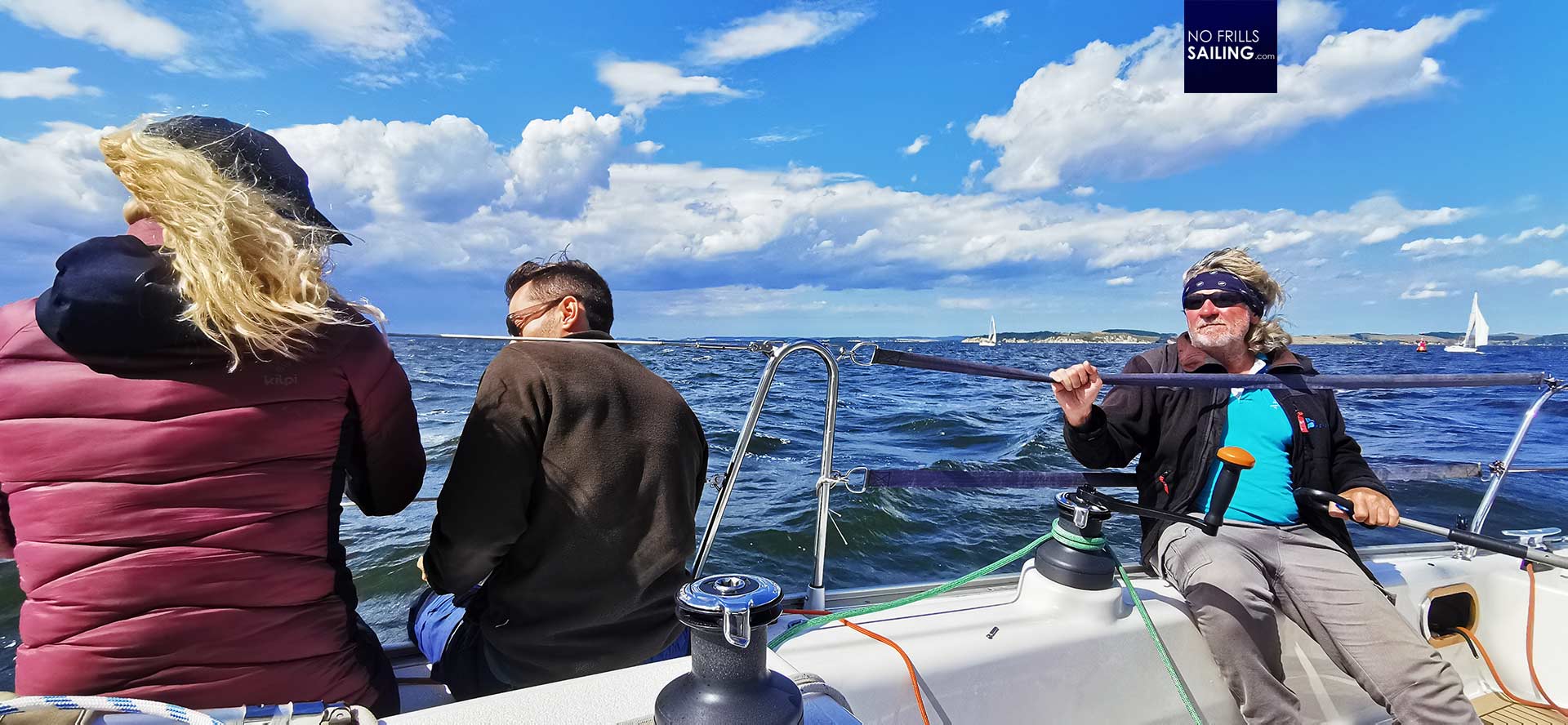
Disrespecting our way of right and judging their high speeds (we were already luffing but much slower) it became clear instantly that our opponent would not bear away and grant us the right of way. At this moment, to our shock, the other two yachts from leeward had approached the buoy as well so that it was impossible to bear away to let the crazy classic through, Stefan, in the last moment, hat to lay in hard starboard rudder, almost tacking. Our Jib began to stall, pushing the bow even more to starboard. The classic yacht rushed by, screaming at us – idiots! – Stefan full port rudder but WINDFAENGER had already lost almost all of her speed! He managed to put our bow to the right side around the buoy by less than 5 centimeters but starting at the position of our shrouds, we slammed into the buoy and slowly scratched alongside around it. What a disaster!

Insisting on their position, the opponent crew behaved very unsportsmanlike and disrespectful. I mean, we were not infighting for a podium´s position here, dammit! It is the end of the race here and those guys sailed as aggressively as if this was the Whitbread to be won! With a lot of anger and rage, we luffed up after shortly inspecting the damage, fortunately only superficial Gelcoat scratches and no damage to the laminate. Nevertheless, it will cost a decent budget to have it repaired professionally. With a hard face we trimmed our sails and brought back the speed.
Heeling in gusts – speeding!
This whole incident was absolutely meaningless a fortiori because we overtook this very boat, the classic yacht that made us hit the buoy, only a few minutes later with absolute ease! What a waste for a two-minute-fame. Anyway, it was an upwind leg ahead of us again and as it seemed, weather forecast that was announcing heavy winds with a weather warning for early afternoon turned out to be the accurate one.

Stefan was still so furious that he didn´t speak a single word for the coming 45 minutes. Stubborn, angry and determined he pushed the boat upwind. With wind speeds increasing to average 20 knots and gusts as high as 25, he did not change the sails configuration, nor reduced sail area. WINDFAENGER now seldom heeled less than 25 degrees and it quickly became an even bumpier and wetter ride. My youngest son was sleeping like a rock downstairs – a reaction I know of him – my older son joined the deck crew and really seemed to enjoy the white caps and the formidable spray coming over.
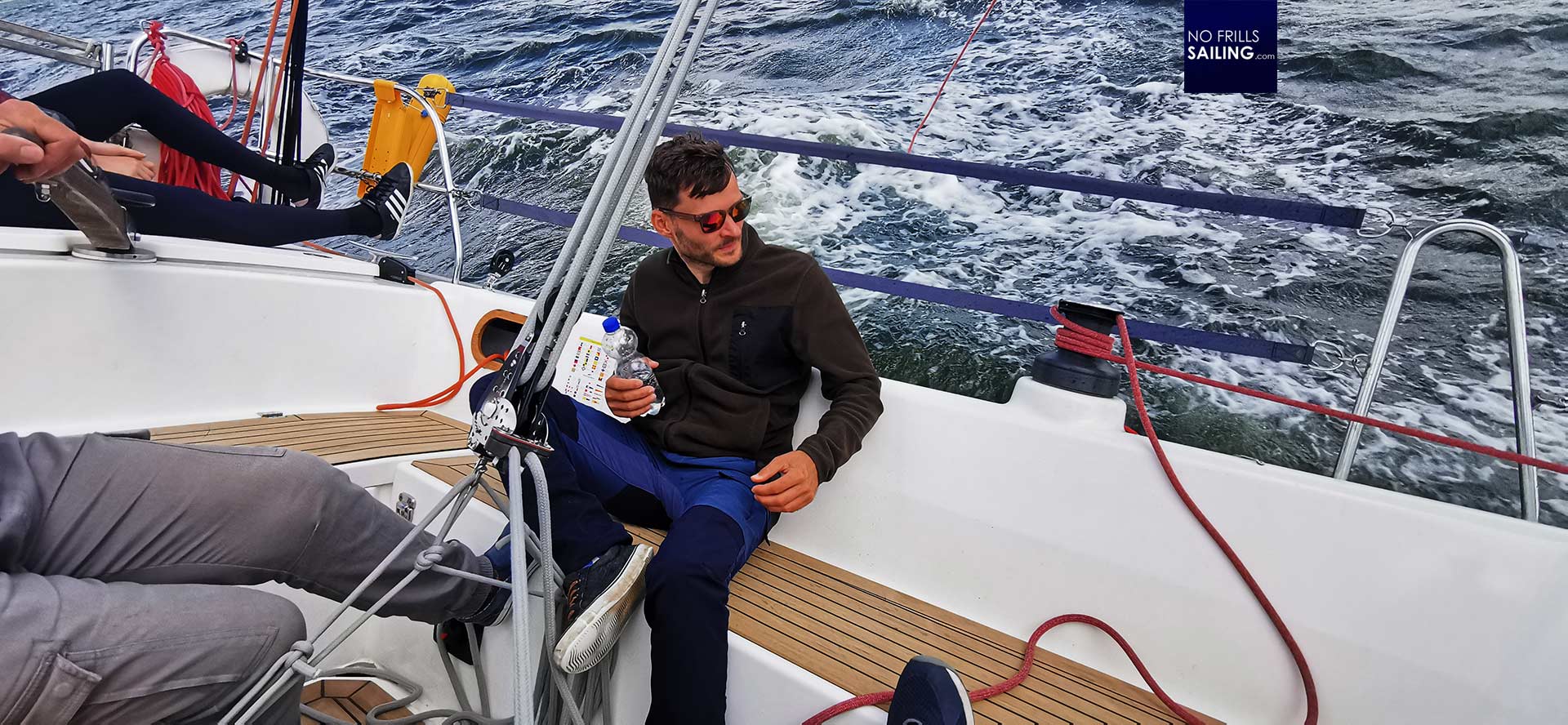
Although wind fetch is minimal on the Greifswald rush area, the high wind speed managed to build up an even bigger sea state. But with waves coming in with a more frequent and synchronized fashion, it really way a lot of fun! Thinking back to my beloved GEKKO, imagining this boat sailing 22-25 knots with 1-1.50 meters steep white caps on a close hauled upwind point of sail, the ride would have been much, much more stressful and hard to bear. Aboard the Omega 42 this is a completely different situation: The sharp V-shaped profile of her forward hull made us cut into the waves and slowly displacing the water instead of flat out bumping onto it. A very re-assuring experience for my own career as a future Omega-skipper: Have no fear of foul weather!
Weather deteriorating
Suddenly the loose clouds formed a completely overcast sky. Though I had the feeling that air temperature became a bit warmer, weather conditions deteriorated. Wind speed increased a little, which was no problem, but guts became far more frequent and every 15 to 20 seconds a violent shaking and ripping on both sails occurred. WINDFAENGER still dashed at 8 to 8.5 knots upwind through the foaming seas, but Stefan soon eased the main a bit.
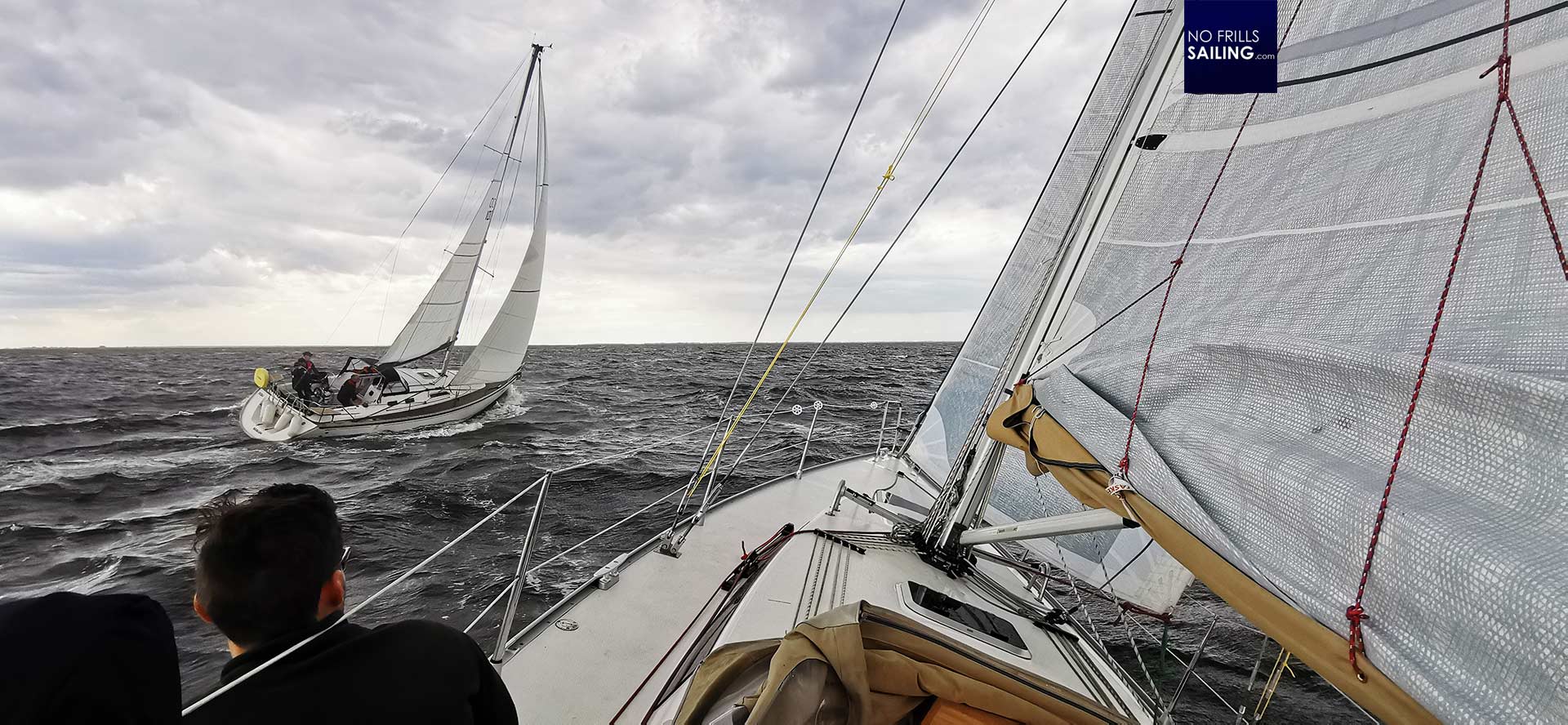
In this we managed to overtake another contender – under full canvas – with ease. Stefan sent us three adults on the high side and went on pushing her hard beating to windward. The main sail only seldom formed the wing shape as Stefan continued to open the main sheet to exit wind pressure. Our Omega 42 was purely driven by the Genoa up to this moment. Amazing sail power! Again, under these conditions, the smaller Jib and our – then close hauled – main sail maybe would have had a better draft, pushing the boat forward.

Nevertheless, even with just the Genoa carrying the full load, our yacht rushed through the field. We managed to catch up and overtake the H-Boat to windward. Tough little yacht, I thought to myself in recognition of the apparent mastery of the other crew: We´ve seen this boat last time during the start of this race and as it seems these guys managed to sail flawlessly ahead of some much bigger yachts. A fact that also speaks for the power of the H-Boat design and more generally, for the high performance of so-called “classic” hull shapes.
A bit of Sydney-Hobart
After a while, still out on the deck´s high side, it went full out dark as an especially thick black rain cloud approached us. The howling of the wind increased into a staccato, Stefan was now driving the boat with main sail almost completely open. Looking abaft to the other boats I could observe the same strategy: Nobody was reefing but rather letting loose their main sails, maybe they were hoping that this big cloud that was bringing much more wind would go by fast so that after a few minutes they could go full throttle again?
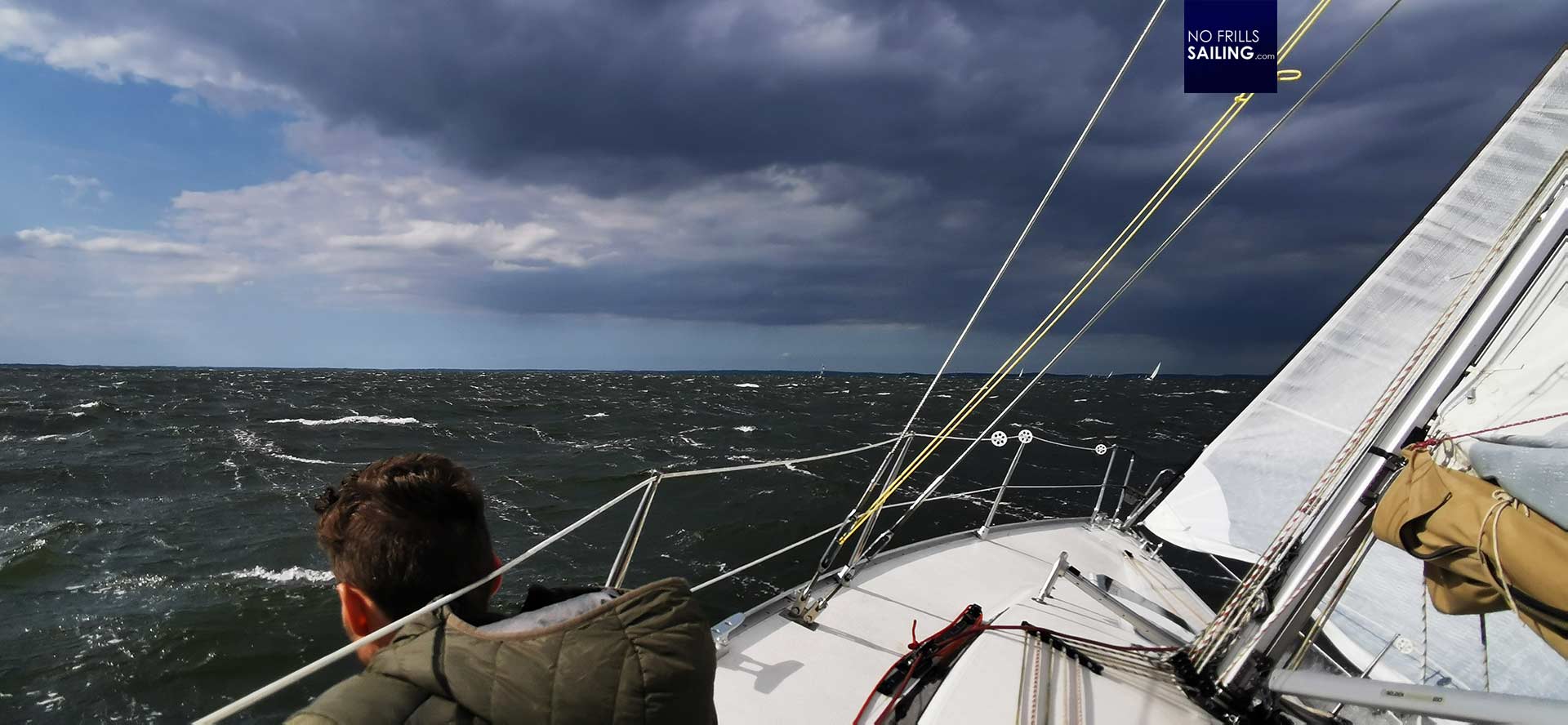
It was a spectacular theatric play unfolding before my eyes! Sitting there, holding onto the railing of the yacht, we saw the waves rolling in, angrily foaming wit white crests, also dragging white wake behind them. The boat sometimes trembled as another gust was exerting its pressure into the rigging. To leeward the intermediate shrouds were hanging loosely whilst there was so much tension in the windward ones. Stefan, focused, determined and hard-nosed held on to the tip of his tiller, still no sign whatsoever for any hard work or pressure on the helm. Amazing!
Final spurt to the finish
After some 20 minutes this “Sidney-Hobart”-leg was over and behind the thick black cloud our beloved clear blue sky with loads of sunshine returned. Wind speed decreased a bit, but only a few knots. We further managed to close the gap to another sailboat, a smaller boat manned by two people. As the “good weather” returned, a kind of hustle started in the cockpit on deck and apparently they got ready to hoist their spinnaker.
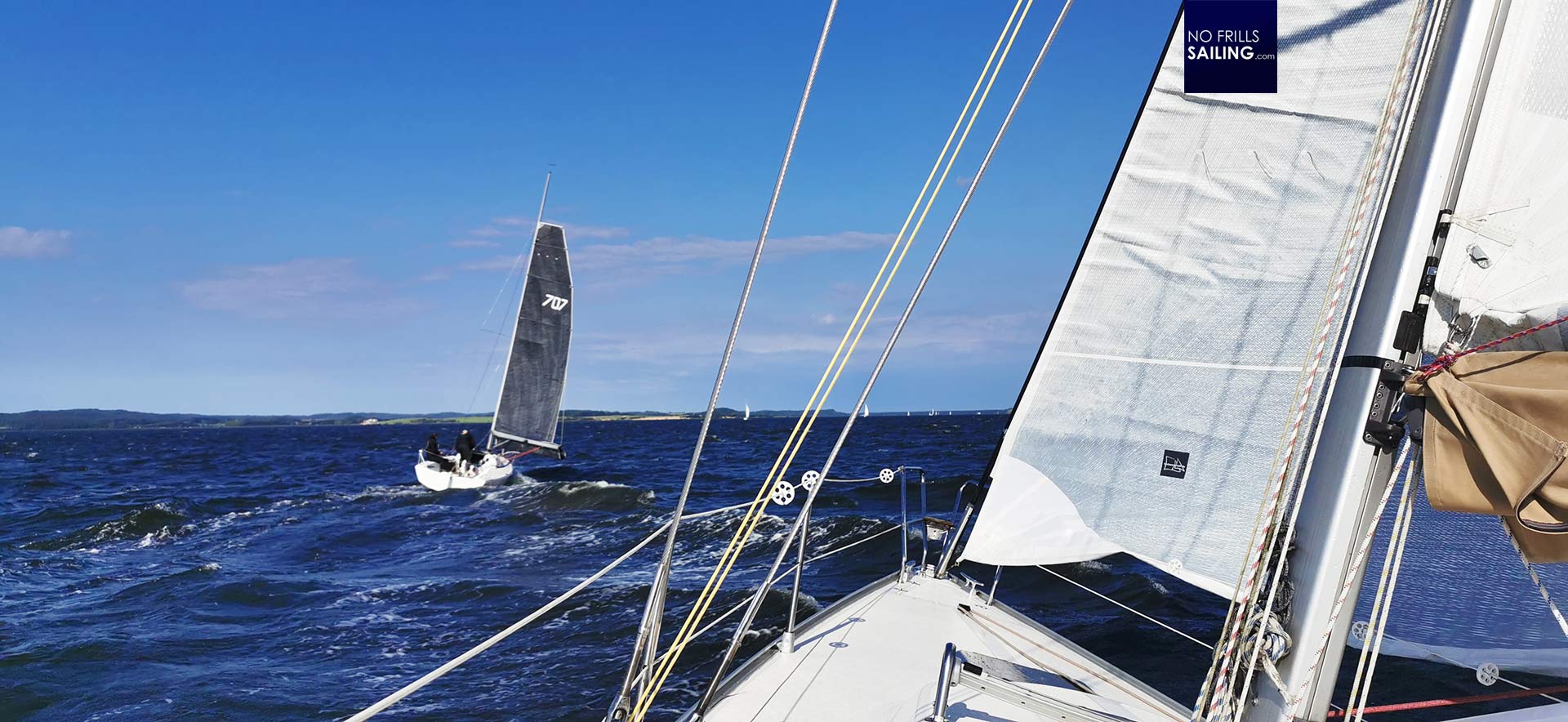
“Now watch and enjoy the show”, Stefan announced. Also, for my taste, there was still too much of wind going on and some pretty nasty gusts rolling in. Even with a much easier to operate gennaker I wouldn´t take out that sail, but a spinnaker? Well, we will see. And just as predicted, the guys only managed to hoist the spinnaker for a short time – but that was impressive! To really see the difference such a large sail area makes in winds like this. Once up, the dinghy literally exploded and jumped forward. Tumbling and battered really hard by the gusty wind, they soon took it down.
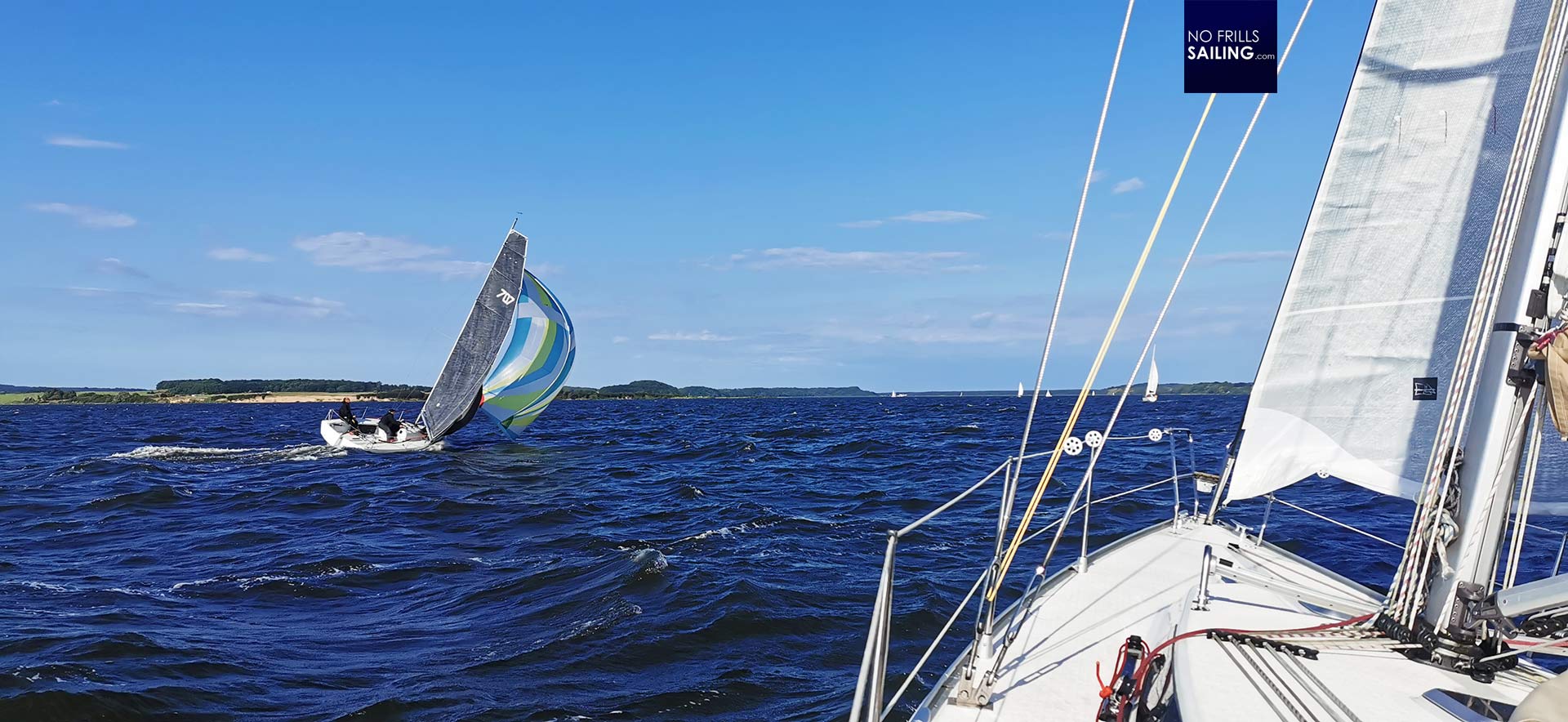
Nevertheless, they managed to get away from WINDFAENGER a couple of ship lengths, opening up a gap we couldn´t close with our limited sails exposed. In the end, we rounded the last marker buoy and stopping our watches almost exactly one minute behind this boat. If you think this through, it´s an incredible revelation. Because, if just a few minutes of spinnaker planning can build up a gap of around one minute, imagine the lead you can create if you manage to hoist the blister for longer? Later during the winner´s ceremony, it was revealed that the first ship home managed to create an almost 1.45 hours advance over our time: This was the boat utilizing the gennaker.
What I´ve learned about the Omega 42
After just under five hours our stopwatch ceased to count any longer. Taking down the sails and preparing the boat to berth again, we were happy, exhausted, exhilarated and – me specially – absolutely overwhelmed by the impressions of that exciting race day. The mayhem at the starting line, our grounding and being towed to float again, marching upwind hard windward beating and rolling through the back of the fiel as much as we could to the last blood pressure and hair raising incident at the last buoy. A race day full of excitement!

And not only that. I´ve learned so much about the sailing characteristics of the Omega 42, valuable information which will help me make the right decisions in equipping my own boat and also later sailing her. First and foremost I am absolutely reassured that my buying decision was right, the choice for this boat. She is a big yacht capable of providing enough space and volume for my family to sleep, eat and roam her down below. I know this because my kids also gave me an enthusiastic thumbs-up after landing the boat in her box when we handed out the welcome home-beers (and Fanta for the kids).
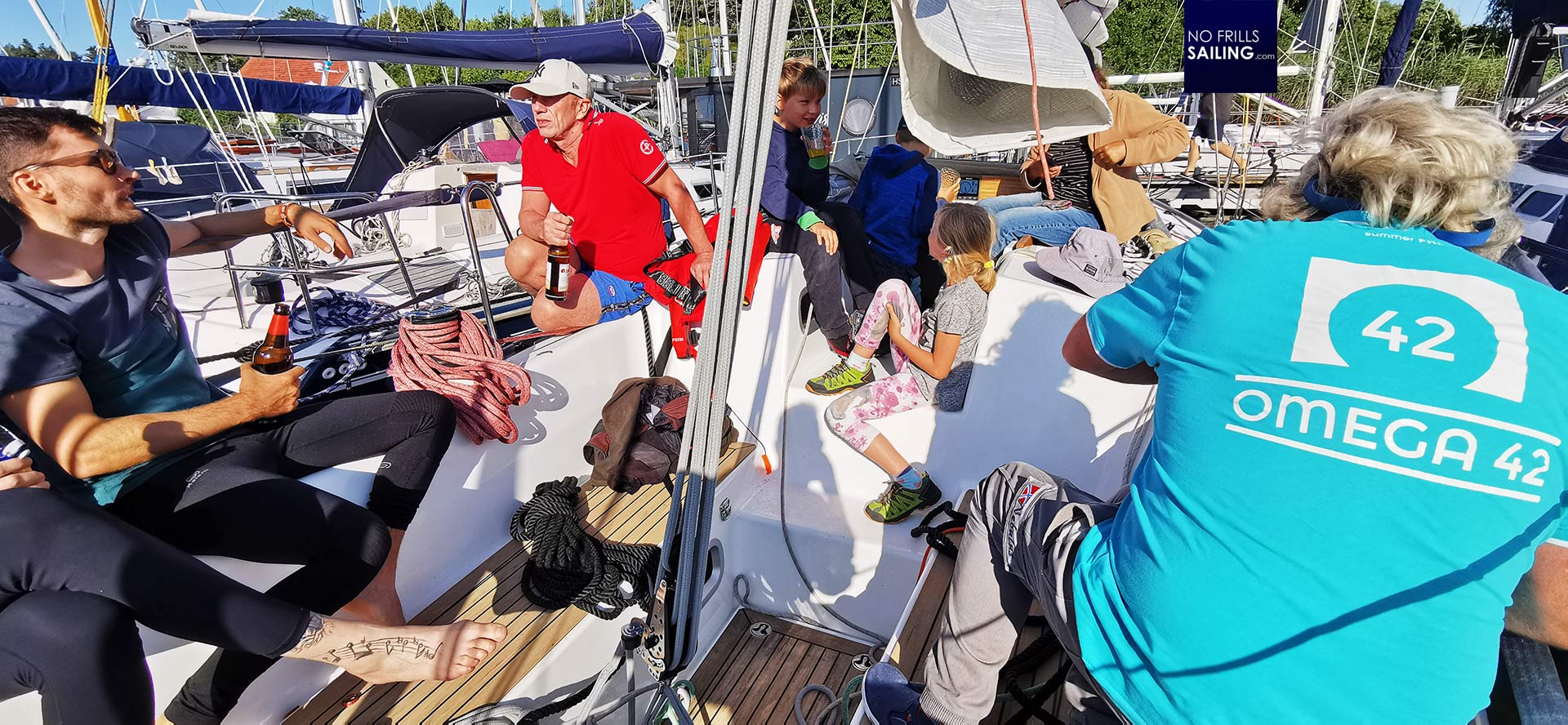
Having sailed her the first time in relatively calm conditions, the experience with the Omega 42 today in harsher sea state and higher wind speeds was formidable. She is an absolute sailing machine! She is very fast on every point of sail – but also retains a very, very comfortable, smooth seakind motion even in heavy seas. No comparison to flat-bottomed modern planning boats. Yes, these yachts may be much, much faster on reaching courses, but today I have seen that on upwind courses and overall, modern flat hull shapes aren´t necessarily faster. For sure, they aren´t moder comfortable.
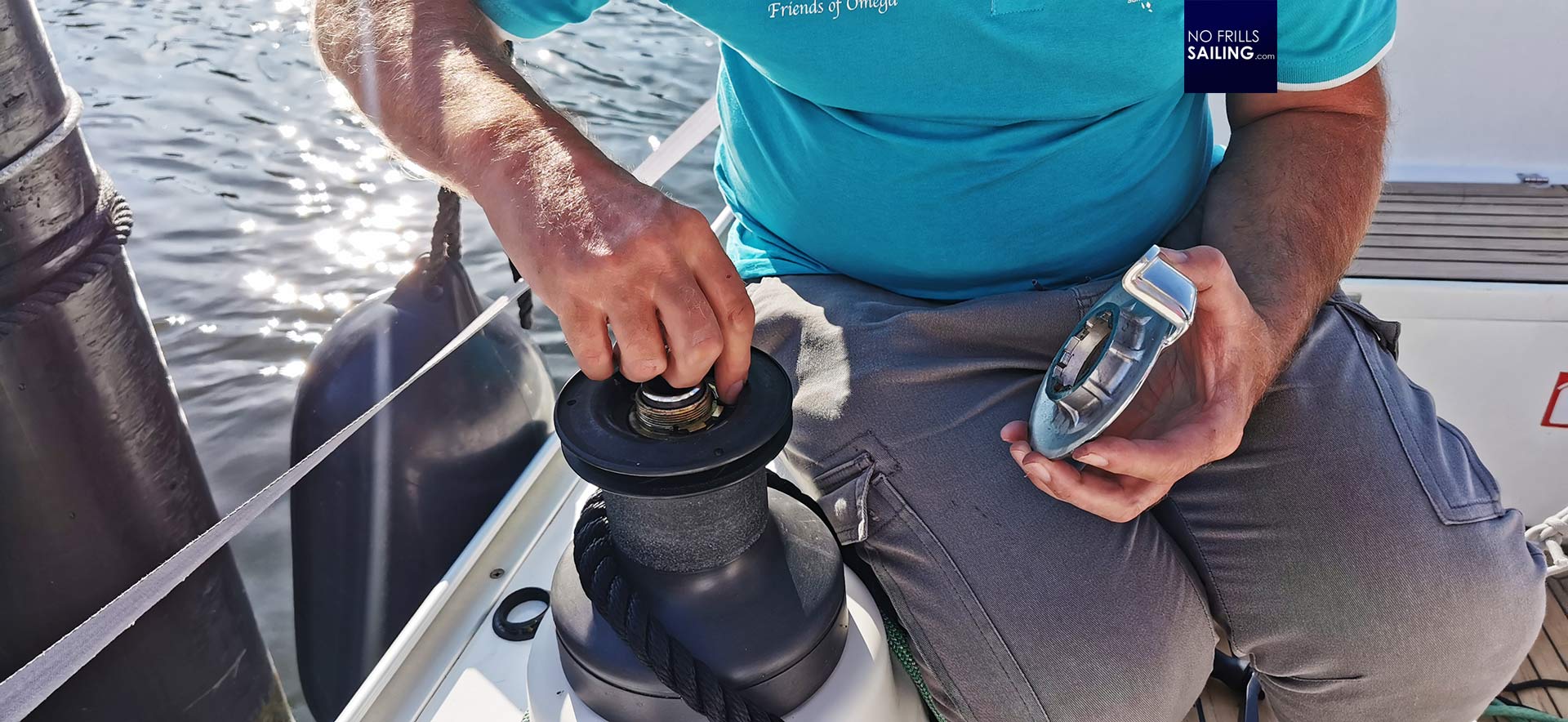
Stefan immediately starts to do some repairs after the race as we clean the boat, inspect the collision damage and also check the keel bolts. Needless to say that this grounding – thank God no rocks involved! – was taken without any scratch, bend or damage by the sturdy Omega 42. Stefan went over to the skipper who towed us from the muddy seabed-table and thanked him personally as we enjoyed a second welcome-beer in the sun. Nearby, the DJ started the party and the sailing club´s brains rotated to calculate the results via Yardstick handicap, of which our Omega 42 has a high 94.
What an amazing day!
After just having two honey buns for breakfast and a lone chocolate bar during the race, our stomachs were aching for some real food. We joined together with Stefan´s family at a table and ordered our well-deserved Schnitzels. I don´t know where to start thanking Stefan for this amazing day: It had everything I hoped for and even more. It was great fun for my kids, who, under the impression of the regatta-excitement – will resume their Optimist career with even more drive now.
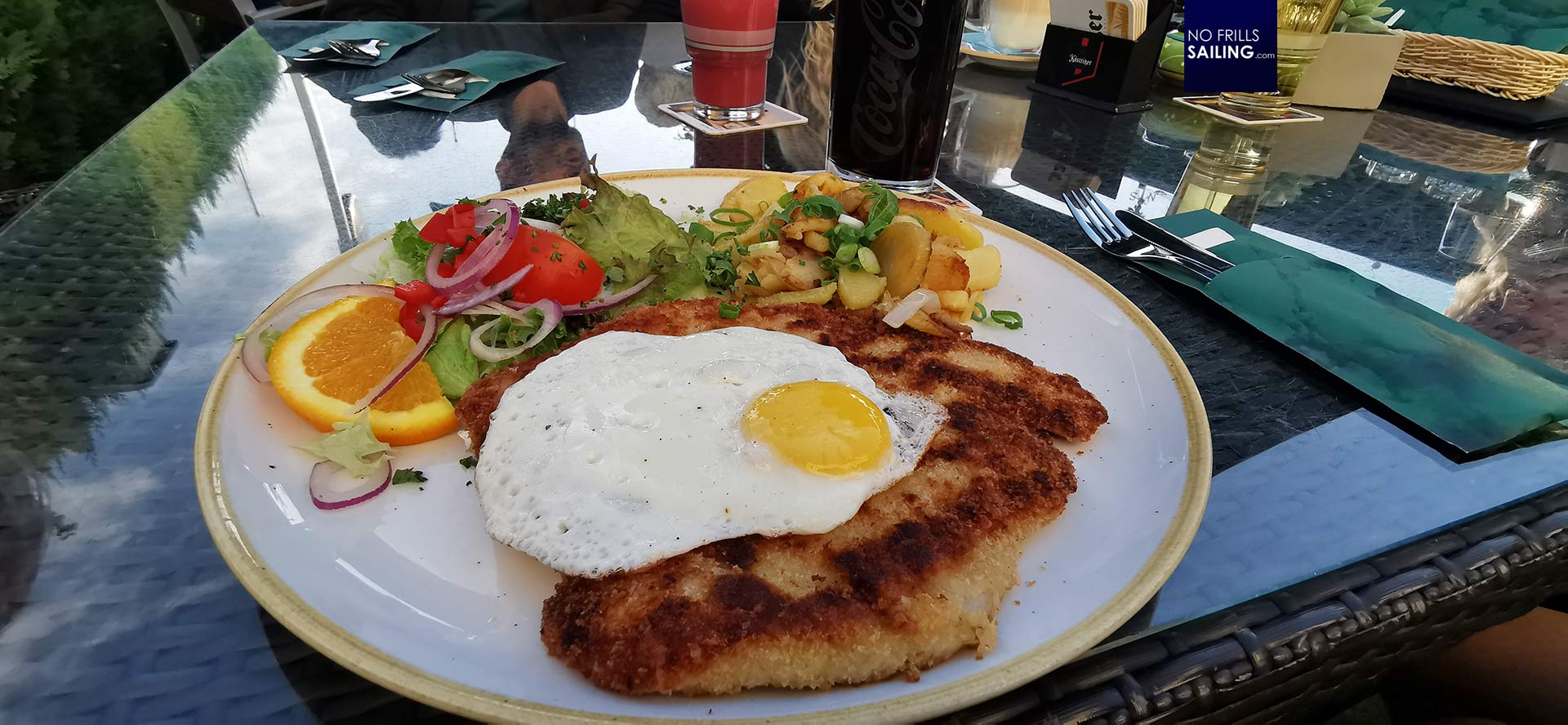
For me, I am not only reassured of having made the right choice, I am really sure that this boat is exactly what I am seeking for my own use-case. Providing a safe, stable platform even in heavy seas for my family and partner at the same time as being a quick boat that can go a high pace on any point of sail. My kids, who kind of hate me (in a nice way though) for selling GEKKO (LINK) approve my decision as well, which is an important thing for me. It would be stupid to do something for the family that the family dislikes. We enjoy the feast, raise a glass or two and talk vividly about the excitement of the day.
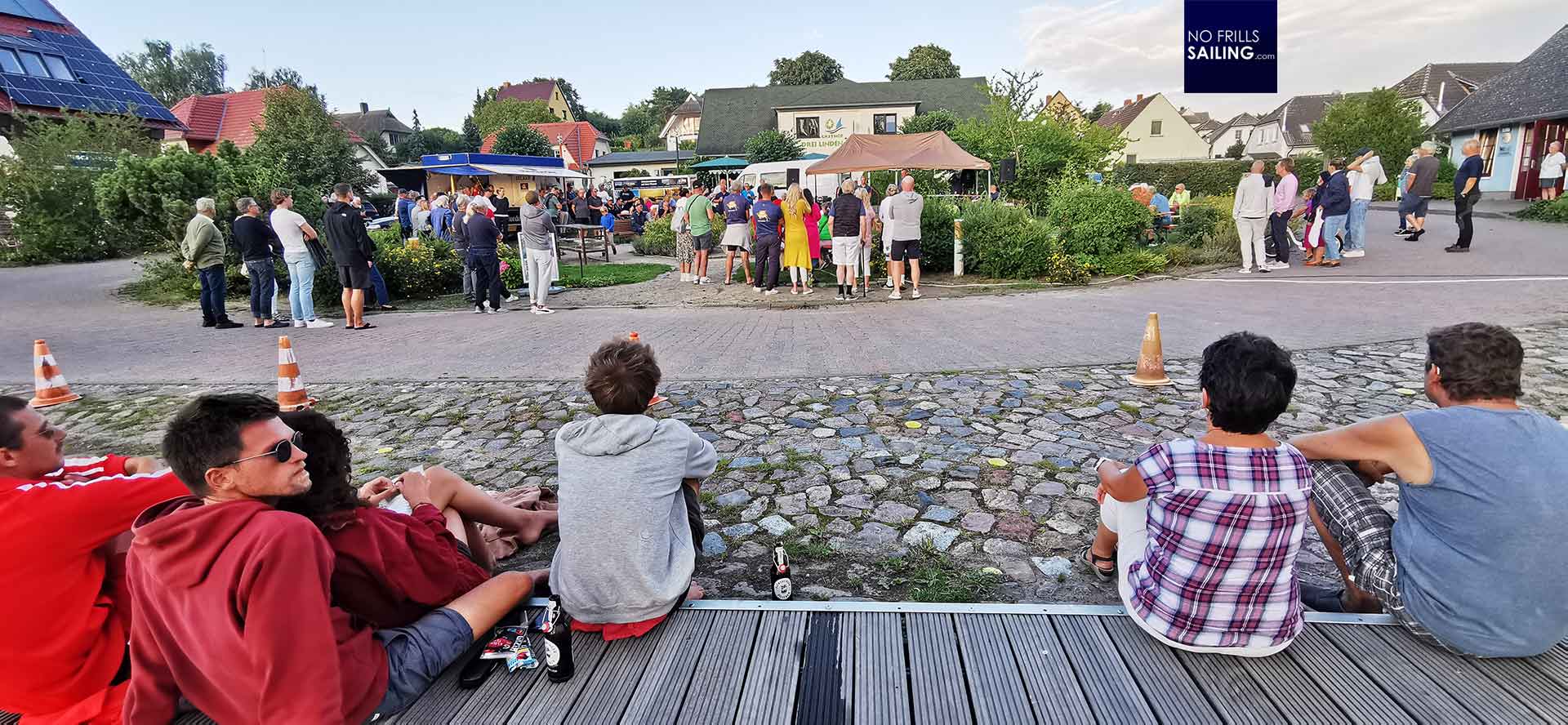
Later, when the winner´s ceremony starts, we keep ourselves a bit in the back. Having lost 20 minutes easily because of the initial grounding and our high Yardstick handicap, our calculated race time equals place 29 out of 33 (with one DNF). That´s not something to go around and brag with, but it´s not so important anyway. We´ve had a wonderful, varied, exciting and absolutely exhilarating day aboard WINDFAENGER, vivid and colorful memories created, especially for the kids. What more could you want from a sailing Saturday at the races? Thanks again, Stefan, Ulrike and WINDFAENGER. I hope we will meet very soon again.
You´ve missed part 1 of the Omega 42 racing day? Klick here
Also interesting to read:
How it all began: Visiting WINDFAENGER in the shipyard, years ago
Omega 42 … what? What is that fuzz all about?
Building progress articles of my Omega 42
